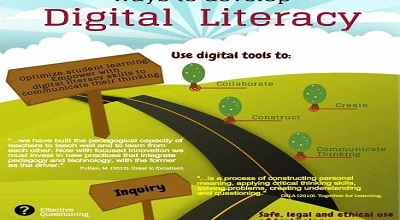Digital Literacy for Educators
Digital Literacy for Educators: In the rapidly evolving educational landscape, digital literacy has become an essential competency for educators. Beyond basic computer skills, it encompasses the ability to navigate, evaluate, and create information using digital technologies. This article delves into the multifaceted nature of digital literacy for educators, providing contemporary examples and practical strategies to integrate these skills into teaching practices.
Understanding Digital Literacy in Education
Digital literacy in education refers to the capacity to effectively and critically navigate, evaluate, and create information using a range of digital technologies. It involves a combination of technical skills, critical thinking, and ethical considerations, enabling educators to enhance teaching and learning experiences.
Key Components of Digital Literacy for Educators
- Technical Proficiency
- Mastery of digital tools and platforms.
- Ability to troubleshoot basic technical issues.
- Information Literacy
- Skills to locate, evaluate, and use information effectively.
- Understanding of digital sources’ credibility and relevance.
- Communication and Collaboration
- Proficiency in digital communication tools.
- Ability to collaborate with peers and students online.
- Digital Citizenship
- Awareness of ethical issues in the digital world.
- Promoting responsible and respectful online behavior.
- Creativity and Innovation
- Utilizing digital tools to create engaging content.
- Encouraging innovative thinking through technology.
Practical Examples of Digital Literacy in Action
- Virtual Reality (VR) in Classrooms: Implementing VR to create immersive learning experiences, allowing students to explore historical events or scientific concepts interactively.
- Online Collaborative Projects: Using platforms like Google Workspace or Microsoft Teams to facilitate group projects, enabling students to collaborate in real-time.
- Digital Assessment Tools: Employing tools like Kahoot! or Quizizz to conduct interactive assessments, providing immediate feedback to students.
- Flipped Classroom Models: Creating video lectures and online resources that students can access at home, freeing up classroom time for interactive activities.
Integrating Digital Literacy into Teaching Practices
- Professional Development
- Engage in continuous learning through online courses and workshops.
- Stay updated with the latest educational technologies and methodologies.
- Curriculum Design
- Incorporate digital literacy objectives into lesson plans.
- Use a variety of digital tools to cater to diverse learning styles.
- Student Engagement
- Encourage students to use digital tools for research and presentations.
- Foster a classroom environment that promotes digital exploration and creativity.
- Assessment and Feedback
- Utilize digital platforms to provide timely and constructive feedback.
- Implement digital portfolios to track student progress over time.
Challenges in Implementing Digital Literacy
- Access to Technology: Disparities in access to digital devices and the internet can hinder the effective implementation of digital literacy initiatives.
- Digital Divide: Differences in digital skills among students and educators can create gaps in learning opportunities.
- Privacy and Security Concerns: Protecting student data and ensuring safe online environments are critical considerations.
- Resistance to Change: Some educators may be hesitant to adopt new technologies due to lack of training or comfort with traditional methods.
Strategies to Overcome Challenges
- Provide Equal Access: Ensure all students have access to necessary digital devices and internet connectivity.
- Offer Training and Support: Provide professional development opportunities for educators to enhance their digital skills.
- Implement Robust Security Measures: Establish policies to protect student data and promote safe online practices.
- Foster a Growth Mindset: Encourage educators to view technology as a tool for enhancing teaching and learning, rather than a replacement for traditional methods.
The Future of Digital Literacy in Education
As technology continues to advance, the role of digital literacy in education will become increasingly significant. Future trends may include:
- Artificial Intelligence (AI) Integration: Utilizing AI to personalize learning experiences and provide real-time feedback.
- Gamification: Incorporating game-based learning to increase student engagement and motivation.
- Global Collaboration: Connecting classrooms worldwide to promote cultural exchange and collaborative learning.
- Lifelong Learning: Encouraging continuous skill development to adapt to the ever-changing digital landscape.
Conclusion
Digital literacy is no longer optional for educators; it is a fundamental component of effective teaching in the 21st century. By embracing digital tools and fostering a culture of continuous learning, educators can enhance their teaching practices and better prepare students for the digital world.
Frequently Asked Questions (FAQs)
What is digital literacy?
Digital literacy refers to the ability to effectively and critically navigate, evaluate, and create information using a range of digital technologies.
Why is digital literacy important for educators?
It enables educators to enhance teaching and learning experiences, prepare students for the digital world, and stay current with technological advancements.
How can educators improve their digital literacy?
Engage in professional development, explore new digital tools, and integrate technology into teaching practices.
What are some examples of digital literacy in education?
Utilizing VR for immersive learning, implementing online collaborative projects, and using digital assessment tools.
What challenges exist in implementing digital literacy?
Issues include access to technology, the digital divide, privacy concerns, and resistance to change.
Latest News in Digital Literacy
Queensland’s Influential Teachers:
The 2024 TEACHX awards in Queensland recognized educators for their substantial contributions to education, including enhancing digital literacy and promoting inclusivity in schools .
Roxbury Community College Hackathon:
Students at Roxbury Community College have organized a hackathon to develop digital solutions using generative AI, aiming to enhance student engagement with online platforms and improve digital literacy among predominantly low-income and students of color .
AT&T’s Donation for Digital Literacy:
AT&T has donated $25,000 to support digital literacy training for adults in rural Webb County, Texas, focusing on enhancing computer skills to help residents navigate technology effectively.
Free Here: WPONE APK
